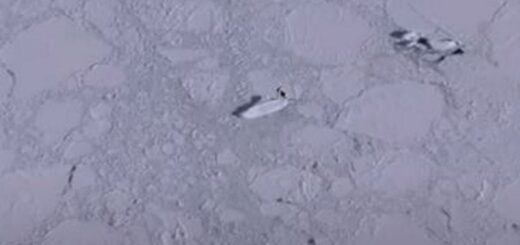How flying snakes are like UFOs

The paradise tree snake undulates mid-flight. (Jake Socha, Virginia Tech.)
A flying snake flattens out into a weird flying-saucer shape in order to get some extra airtime, new research suggests.
The findings, published Jan. 29 in The Journal of Experimental Biology, show that the Southeast Asian snake’s flattened, UFO-like cross-section gives it the right aerodynamic properties for gliding.
“The shape is unusual,” said study co-author Jake Socha, a biomechanics researcher at Virginia Tech. “You never find this kind of shape in any other animal flyer; you don’t find it in engineered flyers. We didn’t know if that was a good shape to have.” [See Images of the Flying Snake]
Gliding animals
The weird flying snake, Chrysopelea paradisi, curls its tail around a tree branch more than 50 feet above the ground before launching upward, curling its body and gliding to the next tree limb.
While birds, and even humans using glider wings, are much better at their airborne maneuvers, the snake’s performance compares favorably to that of other gliding animals, such as flying squirrels, lizards and even ants, Socha said.
Researchers already knew that the snakes curved around, splayed out their ribs to flatten their bodies and undulated as they were airborne but they didn’t know why.
“It looks like it’s swimming in the air,” Socha told LiveScience.
No snake-shaped planes
To answer one part of the puzzle, the team created physical models of the cross-section and tested them in a water tunnel, which, if set up properly, can have the same flow characteristics as air, Socha said.
It turned out that the flying saucer cross-section was a surprisingly good shape to take much better than the cylindrical shape the snake would have if it didn’t compress itself.
Compared to a more familiar flying shape, such as an airplane wing scaled down to snake size, “you’d find the snake is actually comparable,” Socha said.
“The animal has figured out a solution to an engineering problem that we didn’t even know we had,” Socha said.
But don’t expect to board a 747 with flying-snake-shaped wings anytime soon, as the shape wouldn’t be nearly as aerodynamically effective at a plane’s size and speed, Socha said.
Now, the team has to solve another mystery: why the snake undulates once or twice every second while gliding, Socha said.
Copyright 2014 LiveScience, a TechMediaNetwork company. All rights reserved. This material may not be published, broadcast, rewritten or redistributed.



 Creators of mankind
Creators of mankind Description of “Tall white aliens”
Description of “Tall white aliens” Where they came from?
Where they came from? About hostile civilizations
About hostile civilizations The war for the Earth
The war for the Earth “Tall white aliens” about eternal life
“Tall white aliens” about eternal life Video: “Nordic aliens”
Video: “Nordic aliens” Aliens
Aliens Alien encounters
Alien encounters The aliens base
The aliens base UFO
UFO Technology UFO
Technology UFO Underground civilization
Underground civilization Ancient alien artifacts
Ancient alien artifacts Military and UFO
Military and UFO Mysteries and hypotheses
Mysteries and hypotheses Scientific facts
Scientific facts


















